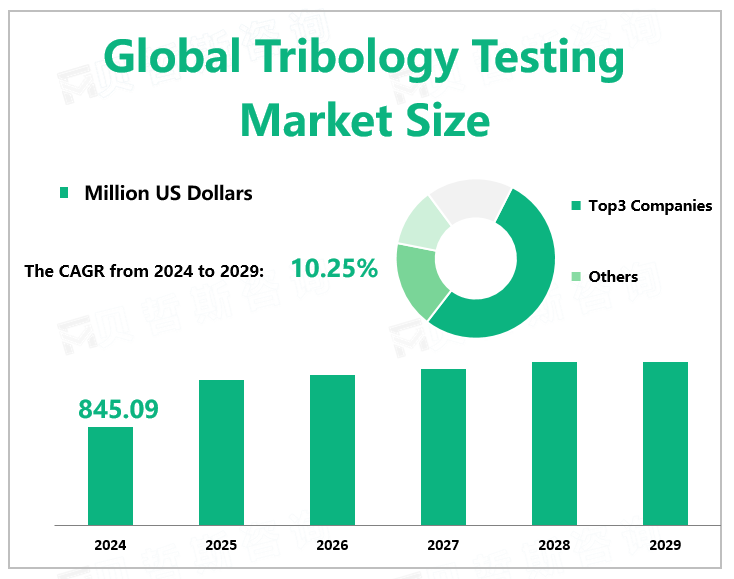Global Tribology Testing Market Overview
According to Global Market Monitor, the global tribology testing market size will be $845.09 million in 2024 with a CAGR of 10.25% from 2024 to 2029.
The science of friction, wear, and lubrication is called tribology. Consequently, tribological testing are mechanical test used to determine the wear, friction, and lubrication properties of materials.
Multiple Demands
All movement or displacement creates friction, which creates wear. Tribology is essential for testing coatings or lubricants that can reduce this wear and ensure that mechanical components work properly. The development of new coatings and lubricants also requires tribological testing.
Some obvious applications are in the automotive industry, where it is used to test pistons, bearings, brake pads, tires, or wipers, among others. Jewelry and paints, coatings, or varnishes are all subject to mechanical friction. Moreover, soft tribology tests can provide comparisons of lubricity in a soft contact situation, similar to skin-on-skin contact processes such as spreading a topical product onto skin or sensing the texture properties of a soft material in the mouth. Also, tribology is important in medical applications, such as implants, catheters or contact lenses, or touch screens, mirrors, and lenses. The orthopedic implant industry, for example, is continuing to grow, but the process of development is fraught with challenges. Biocompatibility of orthopedic implants is critical, but longevity is becoming an important clinical issue as more and more patients exceed the life expectancy of their implants. Therefore, the biomimetic properties of implants are becoming increasingly important. Various mechanical tests are routinely used to study wear phenomena on the surface of the system, such as orthopedic implants fitted into specially designed simulators that allow the investigation of long-term wear of the implant over shorter time scales. Improving the biocompatibility of implants is a permanent task of tribological testing using different test methods. Tribological testing ensures that the product complies with industry standards, thus protecting the environment and improving overall safety. Tribology testing will be driven by the multiple demands for tribology testing in various industries.

Technical Challenges
One of the challenges of tribological testing is that friction and wear values cannot be easily transferred from one system to another, e.g. from tribological test equipment to practical applications. Many influencing factors need to be taken into account when performing friction tests in real environments, such as temperature, humidity, atmospheric conditions, and fluid immersion; however, these are only some of the factors that need to be taken into account, and many practical factors need to be considered depending on the conditions. Therefore, being able to replicate and simulate the environmental conditions under which the tests are performed is essential for obtaining accurate friction test data, and only accurate friction test data can effectively help technicians improve the quality of the products they produce.
Market Competition
As the industry becomes more attractive, consolidation is likely to rise. The widespread use of tribological testing makes it subject to industry developments, and a boom in downstream industries is supporting the boom in analytical services supporting tribological testing. Tribology testing requires a different set of skills, equipment, and certifications than manufacturing companies. And it often makes sense to outsource this work to specialized laboratories. A more accepted regulatory environment is giving rise to new products that require tribological testing of lubricants, for example. Growing demand for testing services is prompting expansion by independent laboratories and the formation of new analytical companies by entrepreneurs. The large amount of equipment and capital required to establish laboratories and subsequent equipment upgrades will, in part, facilitate the emergence of industry consolidation. Many providers of tribology testing services exist as small labs, with varying quality between labs in terms of results and customer service. Large laboratory service companies, on the other hand, offer working capital, more diverse opportunities, and larger footprints.
|
Drivers |
Multiple Demands |
|
Energy Efficiency and Environmental Impacts |
|
|
Challenges |
Technical Challenges |
|
Technical Limitations Applied to Electric Vehicles |
For more industry information, please refer to our latest released "2023 Global Tribology Testing Market Analysis Report, Key Competitors, Market Effect Factors, Growth, And Forecast".
We provide more professional and intelligent market reports to complement your business decisions.